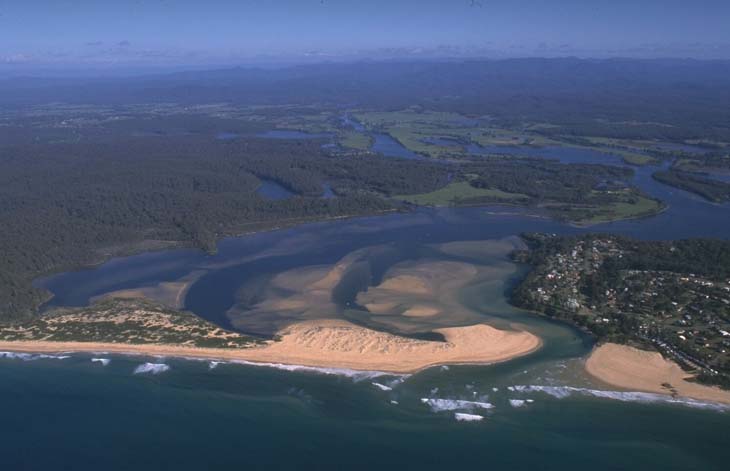The Tuross River estuary is located on the south coast of New South Wales. It is classed as a barrier river estuary with an open entrance. The entrance has been closed to the ocean in the past due to drought.
This estuary is made up of a series of shallow channels and lakes formed behind a large coastal sand barrier. Waterways that form part of the Tuross River estuary include Browns Creek, Browns Bay, Bumbo Lake, Borang Lake and Trunketabella Lake. These waterways are nursery grounds for many species of fish.
This estuary is protected under the Batemans Marine Park as a recreational fishing haven and habitat protection zone.
Water quality report card
As part of our water quality monitoring program we assess the water quality and ecosystem health of an estuary using a range of relevant indicators. We sample a subset of the estuaries between Wollongong and the Victorian border every 3 years. The most recent sampling in the Tuross River was completed over the 2021–22 summer when 2 sites were sampled on a monthly basis.
This report card represents 2 water quality indicators that we routinely measure: the amount of algae present and water clarity. Low levels of these 2 indicators equate with good water quality.
Algae
Water clarity
Overall grade
This report card shows the condition of the estuary was good with:
- algae abundance graded excellent (A)
- water clarity graded fair (C)
- overall estuary health graded good (B).
Grades for algae, water clarity and overall are represented as:
- A – excellent
- B – good
- C – fair
- D – poor
- E – very poor.
Eurobodalla Shire Council have a long-term water quality monitoring program in the Tuross River, based on the same sampling and reporting methods as our state-wide program. The results of the monitoring program, including a detailed water quality report card, are available on the Eurobodalla Shire Council website.
Go to estuary report cards to find out what each grade means, read our sampling, data analysis and reporting protocols, and find out how we calculate these grades.
We have monitored water quality in Tuross River since 2008. This table shows the water quality grades for this estuary over that time.
| Year | Algae | Water clarity | Overall grade |
|---|---|---|---|
| 2008–09 | B | A | B |
| 2011–12 | B | A | B |
| 2018–19 | C | B | B |
| 2019–20 | D | B | C |
| 2020–21 | B | B | B |
Physical characteristics
| Estuary type | Barrier river |
|---|---|
| Latitude (ºS) | –36.07 |
| Longitude (ºE) | 150.13 |
| Catchment area (km2) | 1813.8 |
| Estuary area (km2) | 15.5 |
| Estuary volume (ML) | 18,208.2 |
| Average depth (m) | 1.2 |
Tidal exchange volume
Tidal exchange volume or tidal prism data is available for this estuary. This data was measured in 1994.
| Tide state | Flow (ML) | Local tidal range (m) | Sydney Harbour tidal range (m) |
|---|---|---|---|
| Ebb flow | 5,400 | 0.64 | 1.34 |
| Flood flow | 4,890 | 0.61 | 1.31 |
Notes: km2 = square kilometres; m = metres; m3 = cubic metres; ML = megalitres.
Water depth and survey data
Bathymetric and coastal topography data for this estuary are available in our data portal.
Land use
Tuross River has a large catchment that extends inland to Belowra. The catchment has relatively low disturbance with 85% remaining as forest, including a small area of the Wadbilliga National Park in the western catchment. Over 10% of land is used for grazing and rural residence and about 1% is urban including the townships of Bodalla and Tuross Heads.
Water use
Find out about water use in the Tuross River, including information about major water users, real-time flow data, and environmental and water sharing plans.
National and marine parks
- The largest conservation area in the Tuross River catchment is the Wadbilliga National Park. Cambathin Island, formed in one of the Tuross River channels, is part of the Eurobodalla National Park.
- Tuross River flows into the Batemans Marine Park.
Citizen science projects
- iNaturalist Plants of Eurobodalla is a citizen science project that monitors plants found in the Eurobodalla region.
Community involvement
- Eurobodalla Landcare is a network of 24 Landcare groups in the Eurobodalla Shire.
- Coastwatchers Association is a community environmental and conservation group based in Eurobodalla.
Seafood harvest area status
The NSW Food Authority website lists the current status of oyster/shellfish harvest areas.

Aerial view of Tuross River estuary.
Local government management
Local councils manage estuaries within their area unless the estuary is attached to a marine park.
Eurobodalla Shire Council manage this estuary, which is located in Batemans Marine Park.
Threatened species
Tuross River estuary is home to diverse vegetation, such as mangroves, saltmarsh and seagrass.
A number of threatened bird species occur in the catchment area, such as the pied oystercatcher.
Find out more about the biodiversity in our estuaries.